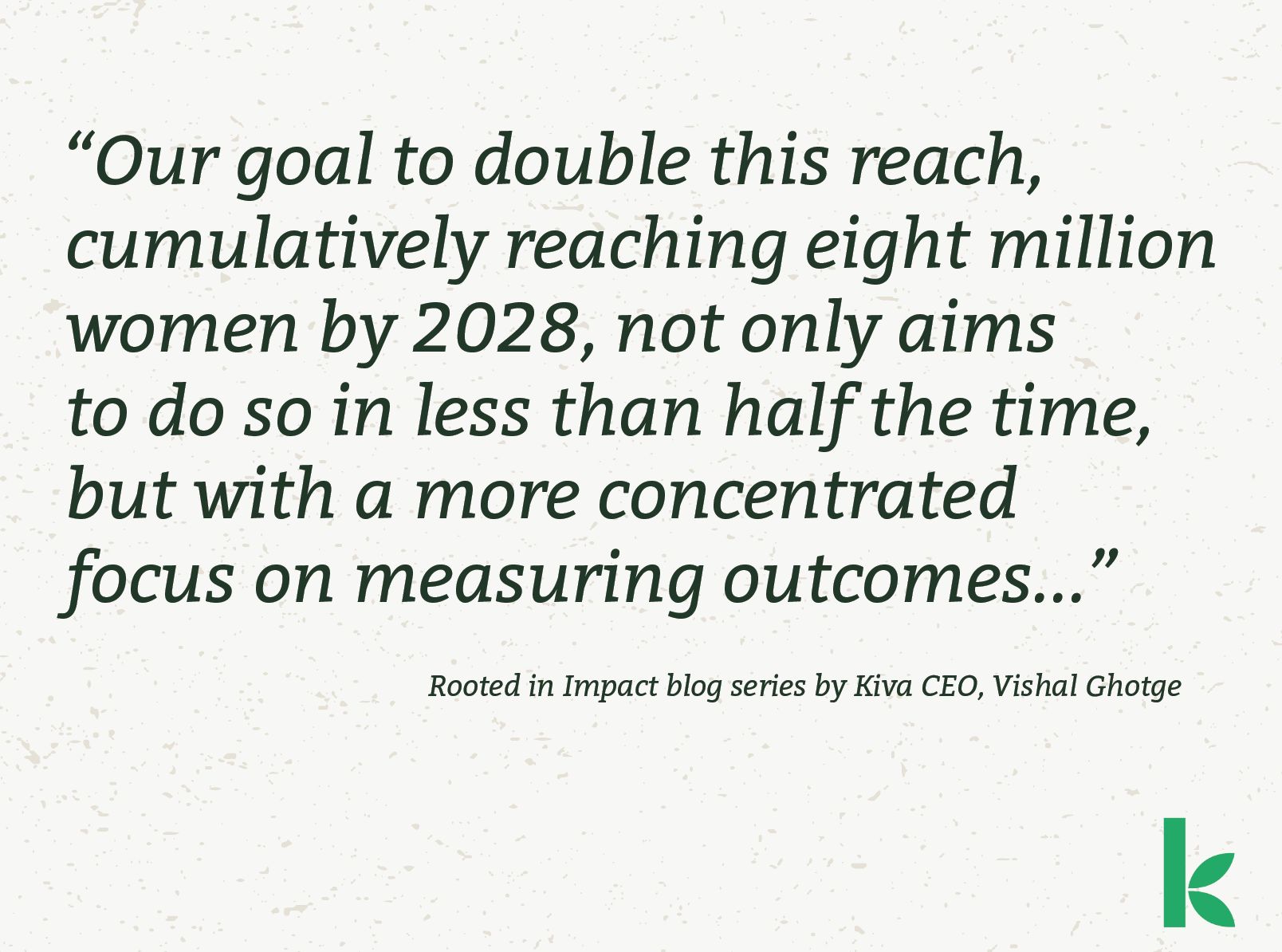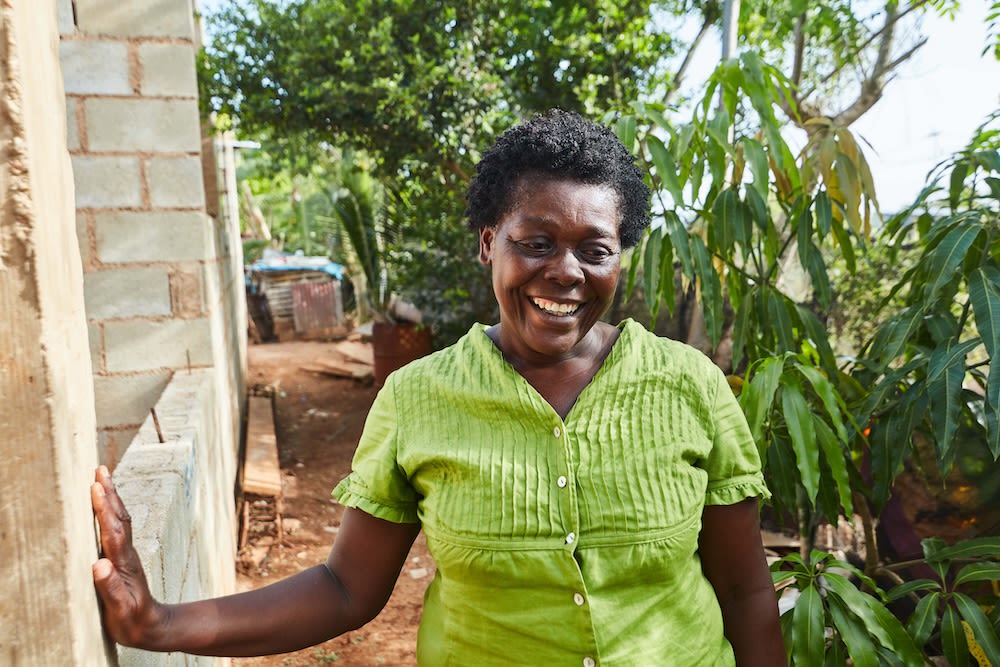What you’ll learn in this article:
How Kiva defines “underbanked women”
What factors lead to more women being underbanked
How Kiva loans lead to better outcomes for women
What Kiva is doing to scale and meet our goal
In November 2023, Kiva announced ambitious goals to scale our reach and prioritize four key population segments for our future focus: (i) Underbanked women, (ii) Climate-affected people, (iii) Refugees and (iv) Systemically marginalized people in the US. Today, I want to share with you more details about our first segment - underbanked women.
Between 2005 and 2023, Kiva helped provide loans to four million women worldwide. Our goal to double this reach, cumulatively reaching eight million women by 2028, not only aims to do so in less than half the time, but with a more concentrated focus on measuring outcomes (understanding how impactful Kiva loans are once the recipient receives their loan).

Defining ‘underbanked’
There are 1.4 billion adults in the world today who are “unbanked” – they do not have access to mainstream financial institutions, loan providers, bank accounts or mobile money providers. On top of that many individuals remain underbanked, meaning they may have access to one or more of these services, but they still must rely on alternative solutions such as check cashers, money orders, payday lending, or pawn shops. Underbanked populations also often pay more to access the limited financial services available to them.
Underbanked adults, many of whom are women, often share several intersectional characteristics: they are usually poor, young, lack access to education opportunities, are inexperienced in finance, and lack a mobile phone or internet access. These combined factors create additional barriers that make it more difficult to start businesses or support their families. For all of these reasons, Kiva’s impact goal to reach 8 million underbanked women by 2028 includes both unbanked and underbanked individuals.
Challenges and opportunities for underbanked women
Factors contributing to an individual being underbanked can be unique to each country and region, but there are similar threads across the globe. Through The Global Findex Database, the World Bank cites lack of money or documentation and distance to nearby financial institutions among the primary reasons why individuals go underbanked. For women, additional factors such as gender-based biases, restrictive social expectations, and legal discrimination have all contributed to women being 20 percent less likely than men to hold an account with a financial institution.
In a world where gender disparities are widespread, correcting these inequalities is not only the right thing to do, but there are also strong indications that when women participate in the economy, communities across the world grow and thrive. The World Bank estimates that on average, long-run GDP per capita would be nearly 20% higher if gender gaps were closed. Kiva identifies the immense opportunity for greater financial access for underbanked women across the Middle East, North Africa, Sub-Saharan Africa, South Asia, as well as within the United States.
Addressing finance gaps leads to long term, positive outcomes
As shared in a previous post, we are enhancing our assessment approach in order to scale in ways that center quality in addition to quantity. This recent insights report by our partner, 60 decibels, shows promising results for women borrowers who work with financial service providers (what Kiva refers to as our Lending Partners).
Of the over 30,000 women borrowers interviewed by 60 decibels, 71% reported increased savings and 89% report their quality of life has improved after receiving loans and services through their financial service providers. What’s even more compelling is that women were more likely than men to report an increase in spending on things like home improvements, education, healthcare visits, and quality of meals as a result of their improved income. These outcomes alone prove that once equitable access to financial products is available, women are able to improve their circumstances beyond their businesses.

A real-life example of how women benefit from these opportunities is Ena, a Kiva borrower. Originally from Haiti, Ena moved to the Dominican Republic to escape poverty and instability. Thanks to Kiva loans, she has successfully run a clothing store for over 15 years. This success enabled her to buy a home for her family and support her daughter Monica's dream to study civil engineering. Ena says, "These loans have completely changed my life."
How we reach our goal: Inspiring new lenders and partners
Behind each Kiva loan is the vast and inspired network of individuals and partners who crowdfund the money to support our borrowers’ dreams. Reaching 4 million more women between now and 2028 means that crowdfunding network will have to get a whole lot bigger. This call to action has inspired us to experiment with new Kiva.org offerings for both individual lenders and corporate partners.
Lending communities
We’re developing new ways to engage our global lender communities on Kiva.org through enhanced offerings that harness the passion and spirit of lenders and lending teams. We’re approaching this through two distinct efforts focused on the importance of communities and harnessing the power of gamification to drive social impact.
While individuals choose to lend on Kiva.org to make a difference, our model of crowdfunding showcases the power of collective action. Each loan is supported by dozens, sometimes hundreds, of individuals around the world, demonstrating how people can do more together than we could alone. To build on this core aspect of our model, we’re focused on enhancing the teams experience on Kiva.org. We recently launched a pilot that challenges lending teams to support a set number of loans that align with their focus within a designated period of time. Early results from the pilot have been successful and we see an opportunity to inspire and motivate new lenders to join teams and witness the compounded impact of their efforts alongside others.
In terms of gamification, we’ve introduced individual challenges related to impact populations and key moments in Kiva’s calendar, such as International Women’s Day. Over the past year, when lenders make a loan tied to one of these campaigns, they are rewarded with a badge to mark their contributions. The response to badges has been very positive and we plan to continue enhancing this gamification approach. Our lenders do an endless amount of good in the world through each $25 loan contribution and we want to ensure they enjoy the lending process while also seeing the impacts of their support validated, inviting more lenders to support more borrowers in the pursuit of their dreams.
Organizational partnerships
In addition to new ways to engage as a lender on Kiva.org, we are developing new tools for our corporate and organizational partners, who contribute to our impact through their corporate social responsibility efforts. We’re launching new user experiences that enable strategic partners to see and share their global impact at a glance, engage their customers and employees in meaningful ways, and tie their efforts to one or more of our four impact populations, including underbanked women.
We believe each of these initiatives will add value for individuals and organizations who choose to make their impact with Kiva, leading to bigger audiences and stronger relationships that ultimately help us scale and reach more borrowers.
How we reach our goal: Lending Partner network advancements
Internationally, Kiva reaches borrowers through our vast network of Lending Partners, the local financial service providers who serve as leaders and contributors to their communities. We’re building new methods to strengthen our relationships with Lending Partners and understand the critical work they do to serve borrowers, not just through loan offerings but through trainings, education programs, and more.
One new method we are excited about is our recently launched Gender Equity Assessment Tool (GEAR Tool), developed in collaboration with the United States Agency for International Development (USAID). GEAR will assess how well Lending Partners, and financial service providers more broadly, incorporate gender equity in their products, practices, and policies and help us identify new opportunities to mutually improve our work with women. By revealing where interventions are needed most and sharing that knowledge among the financial inclusion community, we will take meaningful steps toward building a stronger system of support for women around the world.
When we better understand the unique barriers women face, we can create solutions that more accurately meet their needs, leading to better outcomes and more opportunity to scale in regions where our work truly matters.
On the road to 8 million women with financial support
While we are just beginning the journey to our ambitious 2028 goals, I am confident each of these approaches will add a strong foundation for achieving our vision. As we forge ahead to serve an additional four million women over the next four years, I challenge fellow leaders, organizational partners, and industry experts to recognize the critical importance of supporting women globally. Whether you are an individual who wants to support a woman’s dreams, a Kiva lender who wants to spread the word, or an organization ready to partner to invest in women at scale, we invite you to join us in building a future where financial inclusion knows no gender boundaries.















